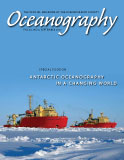First Paragraph
In recent years, mass loss from the Antarctic Ice Sheet has contributed nearly 0.5 mm yr–1 to global mean sea level rise, about one-sixth of the current rate (Church et al., 2011). Around half of that contribution has come from accelerated draining of outlet glaciers into the southeast Amundsen Sea (Rignot et al., 2008), where the flow speed of Pine Island Glacier (PIG; Figure 1) in particular has increased by over 70%, to around 4 km yr–1, since the first observations in the early 1970s (Rignot, 2008; Joughin et al., 2010). The accelerations have been accompanied by rapid thinning of the glaciers extending inland from the floating ice shelves that form the glacier termini (Shepherd et al., 2002, 2004). One implication of these observed patterns of change is that the mass loss has probably been driven by changes in the rate of submarine melting of the floating ice shelves. The ubiquitous presence of warm Circumpolar Deep Water (CDW) on the Amundsen Sea continental shelf, at temperatures 3–4°C above the pressure freezing point, was first revealed during a 1994 cruise of RVIB Nathaniel B Palmer (Jacobs et al., 1996). Repeat observations at the Pine Island Ice Front made from the Palmer in 2009 showed that submarine melting of PIG had increased by 50% over the intervening 15 years despite a modest rise in the temperature of CDW of only about 0.1°C (Jacobs et al., 2011). While ice front observations were able to document those changes, the reason for the dramatic increase in submarine melting would have remained speculative while the ocean cavity beneath the approximately 65 x 35 km, fast-flowing, central part of the ice shelf remained a black box.

